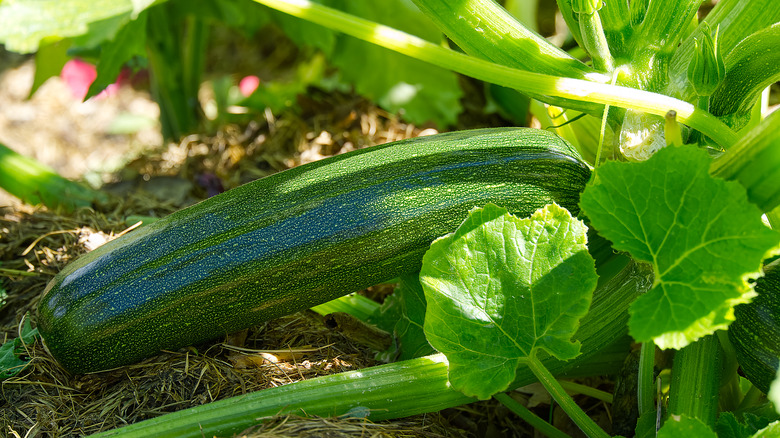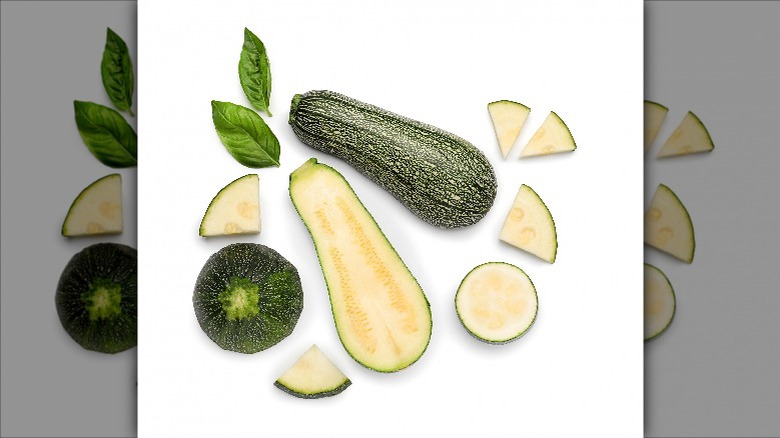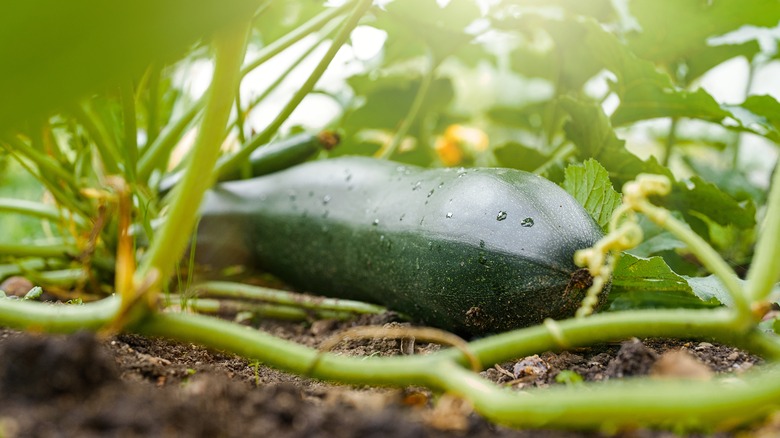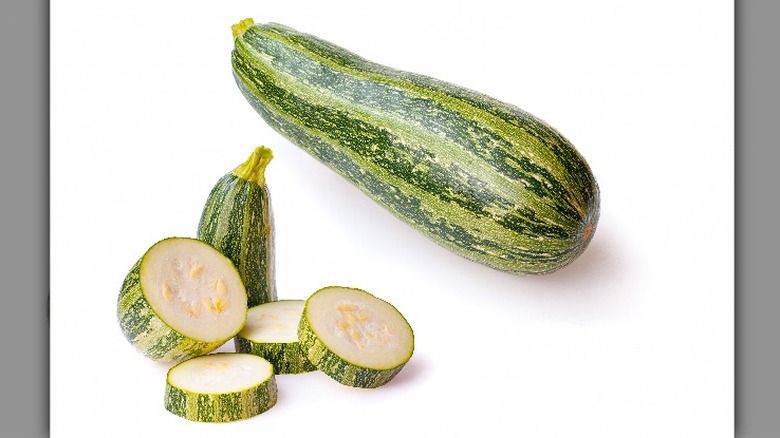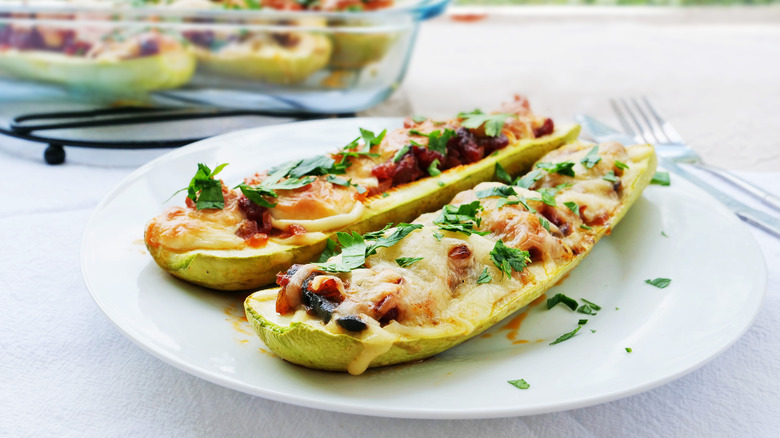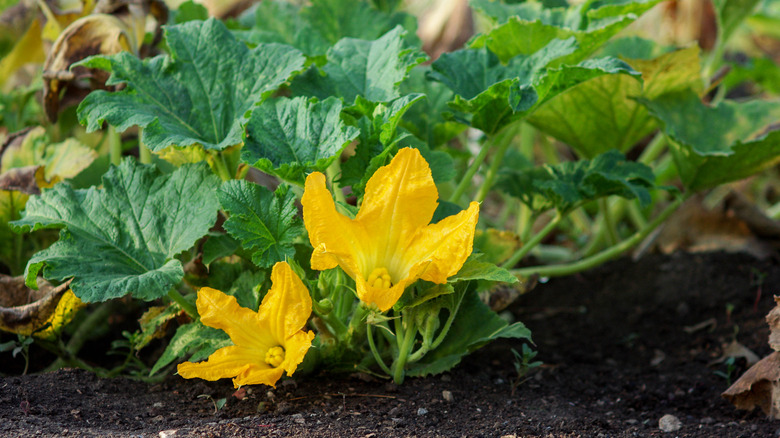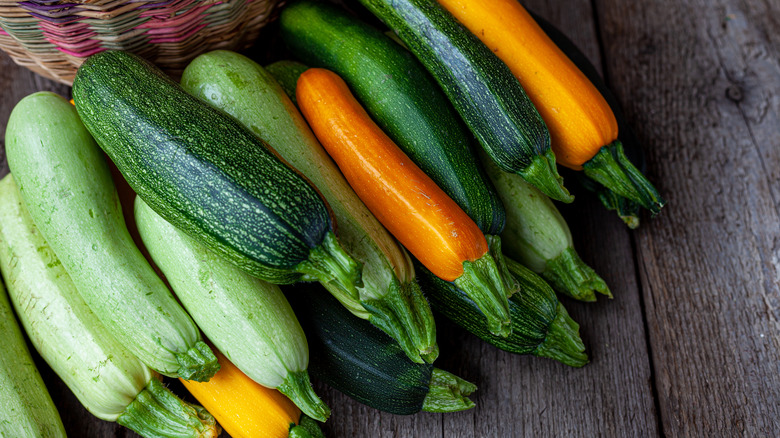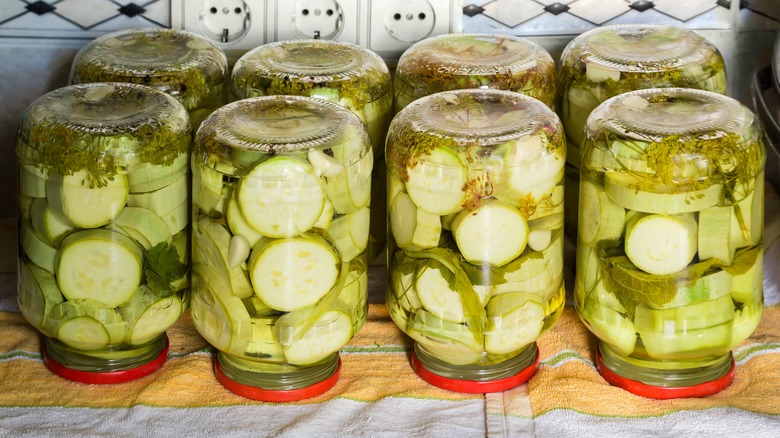What Is Marrow Squash, And What Does It Taste Like?
When you think of the word marrow, unctuous gelatinous material at the center of a roasted beef thigh bone or a piping hot bowl of osso buco might come to mind. While this is indeed a delectable type of marrow, there is another kind that you might want to incorporate into your culinary vocabulary and arsenal of recipes: Vegetable marrow or marrow squash.
Vegetable marrow is a type of squash, closely related to zucchini, that gets its name from the spongy interior of the fruit. When cooked, it somewhat resembles its etymological meaty cousin. It is an often misidentified fruit that cooks like a vegetable and is sometimes hard to come by in the U.S.
That said, it is a distinct food that has some remarkable attributes. Let's dig into what marrow squash is, how it differs from zucchini and other squash varieties, what it tastes like, and how to cook it.
What is marrow squash?
The most useful lens to explore marrow squash would be to discuss what it is not. Though marrow squash is often described as a zucchini that has been left on the vine far longer to ripen, it is, in fact, a different plant. Marrow squash and zucchini are members of the Cucurbitaceae family of plants, including cucumber, melon, summer squash, and winter squash.
These fruits, which grow on vines, are indigenous to the Andes and Mesoamerica and have been cultivated for around 2,000 years. Eventually, they spread from the Americas to Europe and beyond.
Zucchini and marrow squash are classified as Curcubita pepo, with the zucchini being of the cylindrica variety and the marrow squash of the fastigata type. These are different cultivars of the same species which have been selectively bred to have specific characteristics.
If this is confusing, it may be helpful to explain this in the context of how cats are bred. All cats are members of the Felidae family, whether we are talking about a Siamese or a Maine Coon. Through breeding over time, these cat breeds have developed into very different kinds of cats, but they are both essentially a cat.
Both plants are heat-loving summer vines, although marrow squash tends to be fuller and requires more space to grow than zucchini. They also need more time to reach maturity before being harvested. And finally, vegetable marrow is less commonly found in the U.S. than in Europe, particularly the U.K.
What does marrow squash look like?
Though you can harvest marrow squash at different stages of ripeness — the same way you might do so with zucchini — it is most often harvested when it has reached a length between 9 and 18 inches. According to the Guinness World Records, the most enormous specimen of marrow squash ever discovered was 5 feet 1.8 inches long, 1 foot 11.6 inches wide, and weighed a stunning 256 pounds 9.8 ounces, begging the question: How on earth would you even tackle cooking something this large?
Marrow squash tends to have a teardrop shape and dark green shiny variegated skin that is quite dense but still edible. The interior of the marrow plant is a light tan or cream-colored and very porous compared with zucchini. It also has more sizable, pervasive seeds along the central vein, which line the length of the fruit.
For anyone who has ever allowed zucchini to mature on its vine for a long time, you may discover something similar in appearance to marrow squash. Although even in its over-ripe stage, zucchini will be slightly less hardy and its flesh somewhat more firm. This is likely where the confusion between zucchini and marrow squash comes from.
What does marrow squash taste like?
The flavor is where marrow squash is quite unique compared with zucchini. While zucchini has a hint of bitterness and sweetness, marrow squash is generally milder in flavor, with the sweetness taking a front seat. This more neutral taste, paired with the porous nature of the flesh of the marrow squash, makes it ideal for soaking up flavor and moisture from whatever dish it is added to. This can result in a buttery-rich texture reminiscent of meat marrow.
The seeds of marrow squash can be more or less edible depending upon when it is harvested. Smaller seeds can be added as is to whatever dish you are cooking. More mature seeds tend to become slightly acrid. These can either be discarded, composted, or dehydrated. These dried seeds are easily pulverized into a type of flour ideal for baking quick breads, flatbreads, or pancakes.
Lastly, similar to other squash varieties, the blossoms of marrow squash are perfectly edible if processed correctly. Once harvested, they should be cleaned, the stamens and stigmas removed, and the pistils picked off. The flavor of squash blossoms tends to be slightly sweet with a hint of earthiness and a perfumey aftertaste that is quite complex.
How to cook with marrow squash
Thanks to its sponge-like tendencies, the flesh of vegetable marrow lends itself to use in recipes with aggressive flavors, including chili peppers, citrus fruits, garlic, bacon, mushrooms, curry powders, and a variety of fresh herbs, such as dill, rosemary, or thyme. It is ideal in any soup, stew, curry, casserole, or other slow-cooking method where the squash can fully absorb these flavors. One of the quintessential stews made with it is Hungarian Tökfőzelék, which combines grated marrow with fresh dill, onions, and sour cream. We grew up eating this dish, and it is absolutely delicious.
This is by no means the only way it can be cooked. Marrow can also be fried, stuffed, roasted, and shredded for croquettes or added to baked goods. Younger marrow squash can be eaten raw in a salad or added to a coleslaw recipe for extra crunch. You may also consider making a jam or chutney with some citrus zest and fresh ginger for a special treat to add to your next charcuterie board.
And, of course, if you plan to use the blossoms, you can stuff these with fresh ricotta, herbs, and lemon zest, before battering and frying them. The fried squash blossoms can be consumed as an appetizer or added to a salad as a more flavorful replacement for croutons for a hint of crunchy texture.
Nutritional information for marrow squash
According to Lybrate, marrow squash, like many other members of the Cucurbitaceae family, are abundant sources of nutrition. They are low-calorie foods that contain several vital nutrients and vitamins. Among the critical vitamins present are vitamin A, vitamin C, vitamin K, riboflavin, thiamin, niacin, vitamin B6, and folate. Nutrients include abundant potassium, magnesium, manganese, phosphorus, calcium, iron, and copper. And finally, they contain high quantities of antioxidants, like beta-carotene.
These confer many purported health benefits such as aiding digestion, anti-carcinogenic properties, promoting heart health, strengthening bones, preventing anemia, reducing inflammation, and regulating blood sugar levels. Should you prefer not to consume your marrow squash, you can convert it into an ointment for treating skin abrasions and soothing inflammation associated with rheumatoid arthritis.
The only contraindication for marrow squash is the presence of cucurbitacins, which are common in all members of this family of plants. These chemicals, produced by the plant, act as a natural protective mechanism to deter pests. They are what cause the inherent bitterness in some specimens. Unfortunately, if consumed in large quantities, they can cause what is known as toxic squash syndrome, according to MedicineNet. Besides creating typical symptoms of gastrointestinal distress associated with other types of food poisoning, severe cases have even resulted in hair loss. For this reason, it is recommended that you avoid consuming overly bitter marrow squash.
Where to buy marrow squash
Even though marrow squash is more commonly grown and used in Europe than in the United States, it is possible to find it stateside. In larger urban areas, you may obtain them in specialty grocery stores or ethnic markets specializing in more exotic produce. You may also find them growing in an urban or community garden. And finally, check out your local farmer's market in the peak of summer. You will likely find them there.
In rural communities, we suggest joining a CSA, which stands for Community Supported Agriculture. CSA typically involves the purchase of a share of the produce or meat a farmer produces annually. Each farm works differently, but often these farms will grow more obscure or heirloom varieties of fruits and vegetables, allowing you to try new things. They may also take special requests at the beginning of the season, asking repeat customers if they have any particular types of products they want to try.
If all else fails, and you have a green thumb, there are plenty of resources online to obtain marrow squash seeds. You can plant these in your garden and reap the benefit of fresh marrow squash all summer long.
How to store marrow squash
Unlike many other summer squash varieties, which are delicate and require refrigeration to maintain freshness once harvested, marrow squash has the advantage of its thicker skin to protect it from deteriorating quite so rapidly. As a result, it can be stored similarly to root vegetables or winter squash, either in a root cellar or another cool and arid location away from direct sunlight. This will enable you to keep them for two weeks or longer.
Once you have cut into a marrow squash, place the unused portion in a Ziploc bag or an airtight container. This can be stored in the refrigerator for two to three days. If you want to keep it longer, we recommend freezing the squash. Ideally, you should cut the squash into cubes and blanch it before wrapping it in an airtight container or Ziploc bag. Frozen squash should keep for 8 to 12 months as long as it is placed toward the back of the freezer where it isn't subjected to temperature fluctuations due to opening and closing the door. If you notice any freezer burn on it, it is best to use immediately or discard it.
And finally, for storage that is shelf-stable, consider pickling or canning marrow squash. As long as you store canned goods properly in an area away from sunlight, moisture, or extreme temperatures, they will keep almost indefinitely. Just watch for any damage to the can, which may indicate contamination by Clostridium botulinum.
